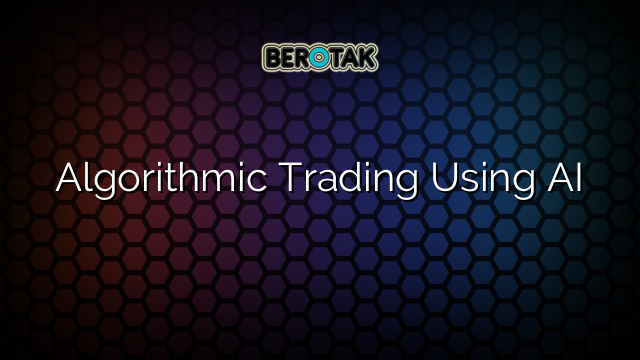
Algorithmic Trading Using AI
Trading with Intelligence: A Guide to Algorithmic Trading Using AI
KAUM BEROTAK, welcome to our in-depth guide on algorithmic trading using AI. In this article, we will provide a detailed overview of how AI is used in algorithmic trading, and the advantages and disadvantages of this technology. We will also provide answers to some frequently asked questions and help you gain a better understanding of algorithmic trading using AI.
What is Algorithmic Trading Using AI?
Algorithmic trading using AI is the process of using computer algorithms to execute trades in financial markets. An AI system can learn from historical data, recognize patterns, and make predictions based on that data to make trades. These algorithms can be designed to buy or sell securities, based on various technical and fundamental analysis techniques.
Algorithmic trading has been around for many years, but the use of AI in trading has gained popularity recently due to technological advancements. AI can analyze large amounts of data fast and accurately, allowing traders to make more informed decisions quickly.
The Advantages of Algorithmic Trading Using AI
1. Speed: AI algorithms can analyze data and execute trades in milliseconds, allowing traders to take advantage of price changes in the market quickly.
2. Accuracy: AI can analyze vast amounts of data and identify patterns that humans may miss. This can lead to more accurate predictions and better trading decisions.
3. Efficiency: Algorithmic trading using AI can run 24 hours a day, seven days a week. This means that traders do not have to monitor the markets constantly, saving time and effort.
4. Lower Error Rates: AI algorithms can operate without emotions, leading to more rational trading decisions. This can reduce the risk of human error in trading.
5. Backtesting: AI algorithms can analyze historical data to test trading strategies. This allows traders to refine their strategies based on historical data and make better-informed decisions in the future.
6. Diversification: AI can analyze and trade various markets and securities simultaneously, leading to a more diversified portfolio.
7. Increased Profitability: Algorithmic trading using AI can lead to increased profitability, as trades can be executed more efficiently and with greater accuracy.
The Disadvantages of Algorithmic Trading Using AI
1. Technical Issues: Algorithmic trading using AI requires a robust technological infrastructure, which can be expensive to maintain. Technical issues can also lead to unwanted errors in trading.
2. Lack of Personal Touch: AI algorithms operate based on data and do not take into account the emotional factors that human traders consider. This can lead to a lack of personal touch in trading, which can be important for some traders.
3. Overfitting: AI algorithms can be overfit to historical data, leading to poor performance in the future.
4. Regulatory Risks: Algorithmic trading using AI is subject to regulations and scrutiny from regulatory bodies. This can lead to legal and reputational risks for traders.
5. Unpredictable Market Conditions: AI algorithms rely on historical data to make predictions. If market conditions change unexpectedly, these algorithms may not perform as expected.
6. Exploitation by Other Traders: AI algorithms can be vulnerable to being exploited by other traders. If a trader discovers an algorithm’s strategy, they can use it to their advantage, leading to losses for the algorithm’s user.
7. Dependence on Technology: Algorithmic trading using AI relies on technology, which can be vulnerable to cyberattacks and technical failures. This can lead to significant financial losses for traders.
Tabel: Algorithmic Trading Using AI
| Parameter | Description |
|---|---|
| Speed | AI algorithms can execute trades in milliseconds, leading to quicker price changes in the market. |
| Accuracy | AI can analyze vast amounts of data and identify patterns, leading to more accurate predictions. |
| Efficiency | Algorithmic trading using AI can run 24 hours a day, seven days a week, saving time and effort. |
| Lower Error Rates | AI algorithms can operate without emotions, leading to more rational trading decisions and fewer errors. |
| Backtesting | AI algorithms can analyze historical data to test trading strategies, leading to better-informed future decisions. |
| Diversification | AI can analyze and trade various markets and securities, leading to a more diversified portfolio. |
| Increased Profitability | Algorithmic trading using AI can lead to increased profitability due to more efficient and accurate trades. |
Frequently Asked Questions about Algorithmic Trading Using AI
1. What is algorithmic trading using AI?
Algorithmic trading using AI is the process of using computer algorithms to execute trades in financial markets.
2. How does AI benefit algorithmic trading?
AI can analyze large amounts of data accurately and quickly, leading to more informed and efficient trading decisions.
3. What are the disadvantages of algorithmic trading using AI?
The disadvantages of algorithmic trading using AI include technical issues, lack of personal touch, overfitting, regulatory risks, unpredictable market conditions, exploitation by other traders, and dependence on technology.
4. Can algorithmic trading using AI be profitable?
Yes, algorithmic trading using AI can lead to increased profitability due to more efficient and accurate trades.
5. Does algorithmic trading using AI guarantee success?
No, algorithmic trading using AI does not guarantee success. It relies on historical data and can be vulnerable to unpredictable market conditions.
6. Do I need to be a programmer to use algorithmic trading using AI?
No, many platforms provide user-friendly interfaces for traders to use AI algorithms without programming knowledge.
7. What are some popular AI algorithms used in algorithmic trading?
Some popular AI algorithms used in algorithmic trading include decision trees, random forests, and neural networks.
8. What markets can AI algorithms trade?
AI algorithms can trade various markets, including stocks, forex, commodities, and cryptocurrencies.
9. Are there any regulatory concerns with algorithmic trading using AI?
Yes, algorithmic trading using AI is subject to regulations and scrutiny from regulatory bodies, leading to legal and reputational risks.
10. How can I minimize the risks of algorithmic trading using AI?
You can minimize the risks of algorithmic trading using AI by testing your strategies with historical data, monitoring the algorithm’s performance regularly, and keeping up-to-date with regulatory changes.
11. Can AI algorithms be exploited by other traders?
Yes, if a trader discovers an algorithm’s strategy, they can use it to their advantage, leading to losses for the algorithm’s user.
12. What are some of the best practices for algorithmic trading using AI?
Some best practices for algorithmic trading using AI include backtesting, diversification, monitoring the algorithm’s performance, and keeping up-to-date with regulatory changes.
13. Is algorithmic trading using AI suitable for all traders?
No, algorithmic trading using AI may not be suitable for all traders, as some traders may prefer a personal touch in trading or have a lower risk appetite.
The Conclusion
In conclusion, algorithmic trading using AI can provide significant advantages, such as increased speed, accuracy, efficiency, and profitability. However, there are also several disadvantages, such as technical issues, lack of personal touch, and unpredictable market conditions, that traders need to consider.
Despite these risks, algorithmic trading using AI can be a useful tool, especially for traders who have access to robust technological infrastructure and a deep understanding of the financial markets. By following best practices and minimizing risks, traders can take advantage of algorithmic trading using AI to make more informed trading decisions and increase their profitability.
Take Action Now
KAUM BEROTAK, if you’re interested in algorithmic trading using AI, take action now by learning more about the technology, testing your strategies using historical data, and keeping up-to-date with regulatory changes. By doing so, you can take advantage of this powerful tool and increase your chances of success in the financial markets.
Disclaimer
This article is for informational purposes only and should not be construed as financial advice. Trading in financial markets involves significant risks, and traders should do their own research and seek professional advice before making any investment decisions. The author and publisher of this article are not responsible for any losses that may occur as a result of trading in financial markets.



